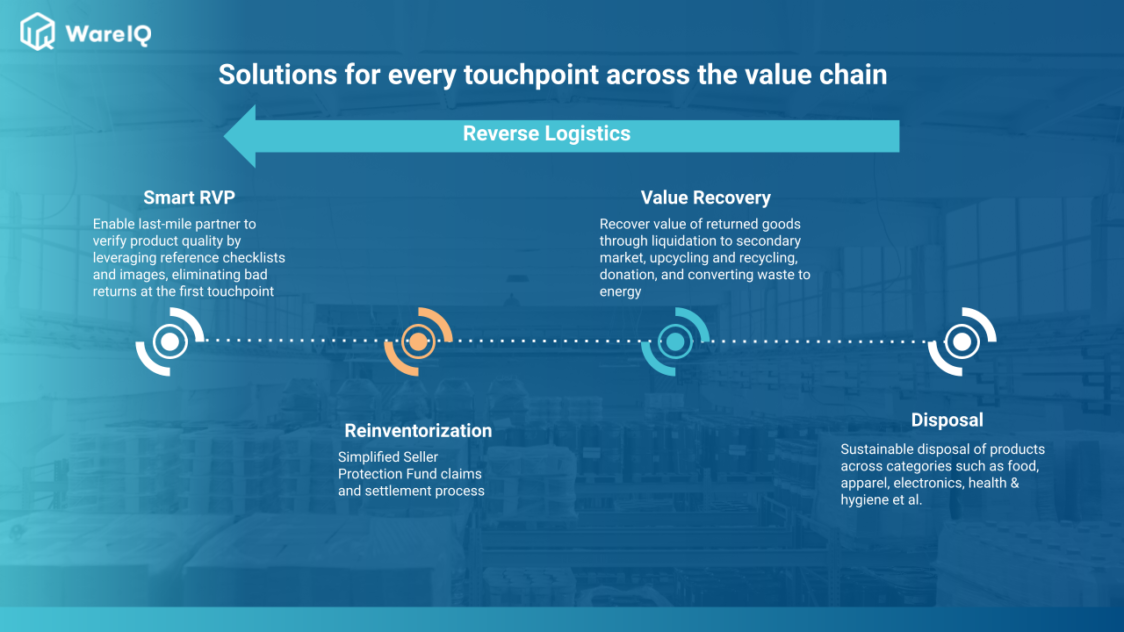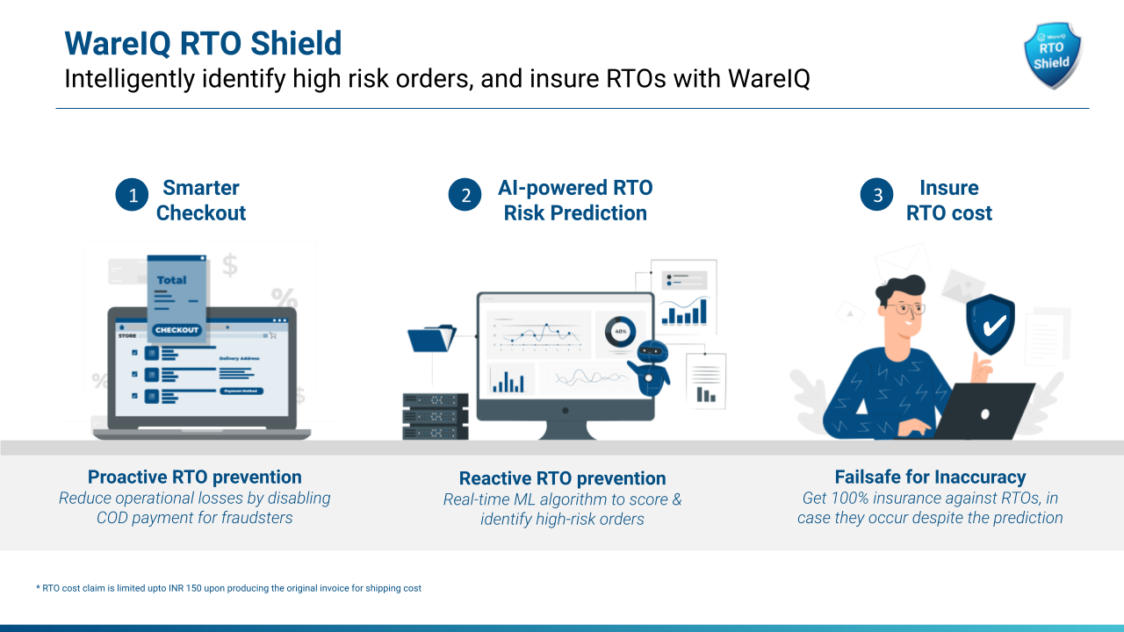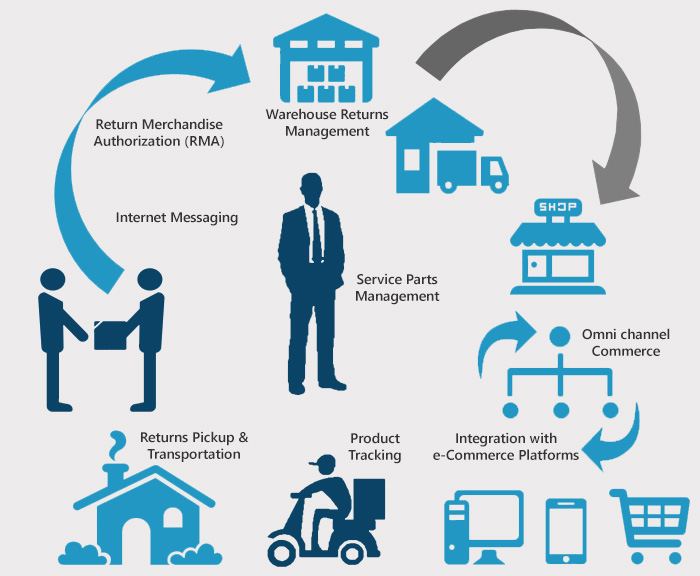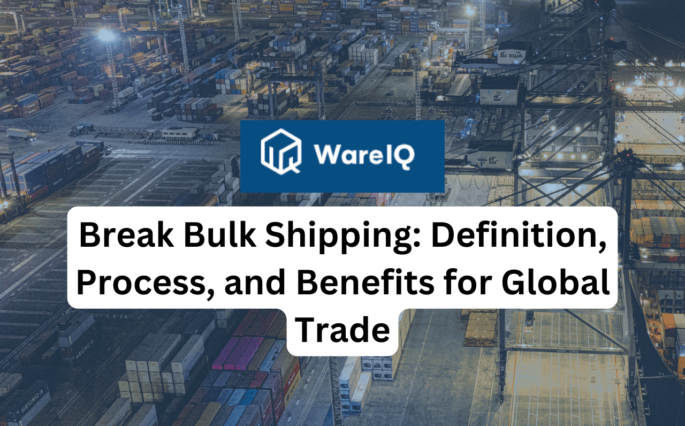Returns Management Process : A Guide for D2C & eCommerce – 7 Best Practices to Enhance Your Return Process

With a drastic increase in online purchases, especially after the health crisis of the Covid-19 pandemic, the eCommerce industry is booming like never before. Most eCommerce and online businesses focus on forward logistics and last-mile delivery to reduce the overall delivery time. But unfortunately, the majority of them miss one of the most critical aspects of the supply chain – the returns management of goods.
The bad news is that almost 30% of online purchases are returned. There may be numerous reasons behind it, but customers often get discouraged from committing to a purchase if the returns management process is complicated. Statistics revealed that 92% of buyers stick to businesses if they can manage returns in a simple way.
- What is Returns Management?
- How to Manage Returns and Exchanges?
- How to Make the Most Out of Returns and Exchanges?
- 6 Key Metrics to Track for Efficient Management of Returns and Exchanges in eCommerce
- 7 Ways to Improve Your Returns Management Systems. [Best Practices in 2023]
- Top 5 Benefits of Optimized Returns Management Process
- Conclusion
- Returns Management System: FAQs [Frequently Asked Questions]
What is Returns Management?
According to research, after-sales service, where returns management is a prominent factor, ranks as the most important metric in building customer trust. Returns management, also known as reverse logistics, is a process where a customer returns the goods they have already purchased. The company then needs to arrange a pick up of the returned items from the end buyer and take them to the warehouse. Mainly, the whole process is triggered, tracked, and controlled through software solutions or mobile applications.
The process does not end here. After receiving the returned product, the company decides whether to dismantle it and keep the useful parts, recycle it, repair the product or scrap it as a whole. The decision depends on the situation and condition of the returned item.
How to Manage Returns and Exchanges?
The returns management process depends on the type of purchase – online or in-store. But regardless of the type, it should be simple and easy.
5 steps of returns management are mentioned below:
Initiation of a Return or Refund by the Customer
The process starts when the customer requests a return of the product that they have purchased. There may be several reasons for wanting to return it such as receipt of a defective product, delivery of a wrong product, improper packaging of the item, buyer’s remorse, or multiple other reasons. The buyer then requests a return through the order tracking page or by contacting customer service and needs to mention why they are initiating the return and whether they need a refund or replacement.
Suggested Read: Why are return labels used?
Acceptance or Rejection of the Request by the Company
Depending on the company’s return policy, the dedicated personnel either accepts or rejects the return request depending on various factors such as the reason for the return and the condition of the product. Usually, the status immediately reflects on the platform, and the customer receives a notification.
Pick-up and Inspection of the Product From the Delivery Address by the Seller
After the acceptance, the seller mentions the expected pick-up date and time and arranges the relevant reverse logistics processes. Though it is a daunting task for the logistics team to manage the forward and reverse logistics, it is crucial for the company’s brand image and customer retention. Some companies often delegate this task to a 3PL logistics company. Delivery partners will assess the condition of the product and report the information back to the seller.
Delivery of the Product to the Warehouse
After collection, the returned product travels back to the warehouse or storage facility. It is then sorted and goes through a strict and detailed quality assessment. If any aesthetic or functional defect is found, further decisions are taken on whether to repair, refurbish or scrap. Else, it moves to an auditor for further analysis.
Restocking the Product in the Inventory
If the product passes the quality check, the warehouse stores and stocks it as per the inventory policy. The product is eligible for sale once again.
How to Make the Most Out of Returns and Exchanges?
Customer returns are an inevitable fact. But you need to find out how to manage returns. Here are some interesting and effective ways to utilize returns management to the fullest extent:
Automatic Data Collection and Analysis
To improve the process, it is imperative to collect all the data you can. Investigate the reason for the return and try to get the customer’s feedback about the return, refund and replacement process. During the analysis, consider all the demographic factors like age, gender, etc. It is helpful to identify all the possible metrics that lead to return so that those same factors can be mitigated in the future.
Better Understanding of the Preferences of Your Customers
An efficient returns management process can tell you about the choice and trends of your customers. The information shared by the customer during the returns management process is beneficial to understanding your buyers’ persona and assists in lead generation and refining your target audience.
Construction of a Robust Return Policy
Prevention is better than a cure. A customer’s return request and how it is managed are indicative of whether your business is able to manage returns or not. Data helps avoid such scenarios. You can get a better understanding of the loopholes to reduce excess costs associated with it. It can highlight the weak points of the return policy and you can craft a more stringent yet customer-friendly policy to avoid losses.
6 Key Metrics to Track for Efficient Management of Returns and Exchanges in eCommerce

- Return rate: This is the percentage of orders that are returned, and it can help you understand the overall effectiveness of your returns process.
- Return to origin (RTO) rate: This is the percentage of returned orders that are not successfully resold and are returned to the supplier or warehouse. A high RTO rate can be costly for your business, so it’s important to track this metric and find ways to reduce it.
- Return on investment (ROI): This is a measure of the profitability of your returns process. You can calculate ROI by dividing the net profit from returned items by the cost of managing returns.
- Customer satisfaction: Tracking customer satisfaction with your returns process can help you understand how well you are meeting their needs and expectations. You can use customer feedback, surveys, and other methods to measure satisfaction.
- Cost of returns: This includes the direct costs of processing and handling returns, such as shipping and handling fees, as well as indirect costs such as lost revenue and lost customer loyalty.
- Time to process returns: The speed at which you process returns can impact customer satisfaction and the overall efficiency of your returns process. Tracking the time it takes to process returns can help you identify opportunities for improvement.
7 Ways to Improve Your Returns Management Systems. [Best Practices in 2023]
The need to manage returns is painful for every company. But it is a part of business and an efficient returns management process can help you to reduce your expenses drastically. We have summarized some key methods for you below:
1. Understand the Controllable and Uncontrollable Aspects of Returns
Customer rejections are costly. If you can identify and analyze the controllable and uncontrollable parts of the returns management process, you can strategically implement the improvements that are necessary.
2. Measure the Cost of the Returns Process
Customer satisfaction is one of the critical aspects of measuring a company’s success. But the ultimate goal of a business is to make money. If the cost of customer return is very high and impacts the business’s bottom line, you need to think of ways to streamline it and reduce some of those costs. A refund could be a more economical option than an outright replacement.
3. Implement a Clear Return Policy
A transparent return policy plays a vital role in mitigating any complications regarding returns management. It helps you to manage returns efficiently, without offending the clients. You can share it on your website, send a hard copy with the shipment, or make it visible on your selling page of every online platform you are listed on. The policy should be easily accessible to the buyers to remove any disparities that could arise later.
4. Analyze the Reasons for the Return
This aspect provides the deepest insight into your returns management process. To manage returns effectively, ask your customers to mention the reason for the return while sending a return request. You can perform the analysis in different ways such as measuring the frequency of the returns of certain items, shortlisting specific geographic locations, manufacturers, etc.
5. Provide a Quick Response and Pick Up
Customer retention is now the focal point of every business. In order to improve their experience, a quick response and returns management process play a crucial role. According to statistics, 88% of buyers do not prefer to buy from a company that has a late response, return or refund process. Focusing on this area helps you retain clients and is also good for better inventory management.
6. Provide a Transparent Tracking Process
Just like the forward logistics during the delivery of an order, a transparent tracking system to manage returns can also help you improve efficiency. An update on the fulfillment status, delivery, and expected time of return through a digital medium or email and SMS notifications improve the trust quotient of your brand.
7. Use a Return Fulfillment Center
Having a separate fulfillment center for returns is a good option if you do not have enough time to manage returns. Nowadays, several 3PL fulfillment companies provide such services. This system provides you with ample time to focus on your core business activities so you do not need to worry about returns management.
Top 5 Benefits of Optimized Returns Management Process
Return management is a cumbersome process. But if you can manage the customer return process efficiently, it can benefit you in several ways:
Improves Profit Margins
Return management is an integrated part of every eCommerce and online business. It is hard to avoid, but if one can manage returns correctly, the process can be improved to increase profit margins. You can do this by:
- Optimizing the transportation expenses of reverse logistics.
- Exploring the option of reselling rather than scrapping returned products. This will save you from a complete loss.
- Trying to repair or refurbish damaged products to be able to resell it.
- Do a detailed rejection analysis, find the root cause, and eliminate the vital issues first. That way, you can reduce the reoccurrence of similar concerns.
Boosts Customer Satisfaction
Returns management may be an underrated aspect from a business perspective. But it is a vital point from a customer’s point of view. If you are unable to manage returns properly, it will directly impact the customer’s feelings about your brand image. The after-sales service is more important than just ensuring your products get sold.
Improves Turnaround Time
A quick return process can help you get back products faster. You can then repair or resell it faster, which helps to eliminate the cost of a new purchase.
Improves Inventory Management
By tracking data on returns, you can gain insights into customer preferences and behavior, which can help you optimize your inventory management and reduce the risk of overstocking.
Reduces Wastage
Efficient returns management entails proper handling of returned products as well. You need to analyze every product and explore ways to be able to reuse or monetize it. A thorough inspection can give you an insight into which products can be resold, which can be repaired at a minimum cost and what items need to be scrapped.
Conclusion
It is now evident that to run a successful eCommerce or online business, you need to take returns management seriously. This does not mean that you need to spend large amounts of money on research and development. You just need to understand the importance of providing a solid returns management process as it will benefit customers as well as your business, in multiple ways. Partnering with a 3PL fulfillment company like WareIQ will give you access to advanced features at competitive prices that you may not have had prior access to.
How Can WareIQ Lower Returns Management Expenses for Your eCommerce Business in 2023?
Quick TAT (Turn around time)
Logistic partners provide an estimated delivery timeline based on which the customers anticipate the delivery. If it fails to reach them as per this expectation, there is a risk of an RTO and the customer opting to order from a competitor. This also affects the customer retention rate. With WareIQ’s Prime-like shipping, data-driven insights, PAN-India network of warehouses and excellent supply chain management system, orders reach the customers on time as promised. This ensures a higher rate of First attempt delivery, thus reducing the breach of TAT.
Higher and Efficient First Attempt Strike Rate (FASR)
Delivery success in the first attempt ensures happy customers and helps in their retention. This is an important metric since lower returns imply lower logistics costs on RTO. With WareIQ’s structured incentive plans, delivery partners are encouraged to deliver maximum shipments in the first attempt thereby increasing the FASR.
Improved Non-delivery Report (NDR) Conversion
Knowing the customer’s intent before performing the last mile delivery can save a lot of time costs related to RTOs. This can be achieved by validating the attempted shipments by directly communicating with customers via phone calls, SMS, e-mail, WhatsApp, etc. Any change of preference or cancellation or order can be recorded and shared to the shipping and delivery partner in real-time to decide whether to “Reattempt the delivery” or “Make RTO”.
Performing this manually at scale is almost impossible. With WareIQ’s innovative solutions, most of it can be automated via IVR (Interactive voice response) calling, auto-SMS, auto-mailer, WhatsApp alerts, etc. This also keeps the customer well informed and creates an impact on improving the delivery conversion percentage. In the auto NDR process, the customer will get an IVR call immediately after a failed delivery or when the NDR remark is updated by the delivery personnel. Automation makes the entire process quick and efficient.

Wrong or Incomplete Address
Amidst the huge traffic across the supply chain and sometimes because of consumer’s ignorance, deliveries often end up attached with wrong or incomplete addresses. This is also one of the major reasons for RTO. Address validation becomes important in this context. WareIQ ensures this authenticity with various checks on the same. This increases the chances of successful delivery. In case of an incorrect address, shipping is cancelled prior to dispatch. It allows not only for lower RTO but also avoids wasteful shipping costs.
Automated Partner Pin Code Allocations
With WareIQ’s cutting edge technology, pin code allocation is automated. This altogether eliminates the hassles of manual allocations thus reducing logistics costs & shipping costs & RTO as well as increasing fulfillment serviceability and speed of delivery. Making changes in allocations is complex and takes a good amount of time. The system analyzes historic RTO percentages and cost per shipment (forward + RTO) to optimize the allocation and ensure that the courier with the lowest possible cost is chosen for the given pin codes. Such efficiency and cost reductions are not possible with manual processes. This also saves a lot of time in processing and shipping the orders.
RTO Shield

WareIQ’s RTO Shield provides eCommerce/D2C firms with a comprehensive checkout strategy to reduce RTO losses and increase revenue.
Why WareIQ’s RTO Shield?
- Request a refund for any RTO order that was predicted to be safe by the company.
- Smart COD checkout option based on technology to detect problematic customers and save on shipping costs
- Disable COD for untrustworthy and blacklisted customers automatically.
- Identification and deletion of duplicate orders
- Verification of shipping addresses and intelligent shipping selections based on address completeness
Benefits of RTO Shield
- Increase conversions and decrease cart abandonment.
- The quickest checkout time is under 10 seconds.
- Identify high RTO risk consumers using data sets from telecom, banks, hyperlocal, and OTT providers.
- Identify scammers using previous data on their past purchasing behavior and win over them.
How Does it Work?
- Integrate the website/application with WareIQ
- 3 months of historical data will be needed to train the model to predict accurately.
- Go live in 3 to 5 days
Sign Up Now with WareIQ to avail our superior fulfillment tech platform & app store & enhance your online business growth by reducing RTOs with RTO Shield.
- Pan India Fulfillment & Darkstore Network: Plug-and-play fulfillment infrastructure with no minimums, which is compliant with Amazon Seller Flex, Flipkart Assured, Myntra and other marketplaces
- Inventory & Network Planning Excellence: Best-in-class AI models for sales forecasting, product segmentation, and inventory management to reduce inventory by 40% and increase revenue by 10%.
- Vertically Integrated Fulfillment Tech Stack: Our Fulfillment Tech Solution supports integrations with 20+ top marketplaces & D2C platforms, and prominent national, regional and hyperlocal couriers, enhancing reach by covering deliveries for 27,000+ pin codes
- Supply Chain Productivity Applications: Integrate a host of supply chain productivity apps with a single-click to your existing CRMs, ERPs & accounting software to manage your logistics workflows from one command center. Use Apps like RTO Shield to get 100% RTO protection, Branded Tracking to turn your order tracking page into a profitable marketing channel, and many more.
Trusted by 300+ top Indian brands, we are helping them accelerate online sales and expedite their growth through a synergistic combination of advanced technology, robust fulfillment infrastructure & seller enablement services!WareIQ is backed by leading global investors including Y Combinator, Funders Club, Flexport, Pioneer Fund, Soma Capital, and Emles Venture Partner.








